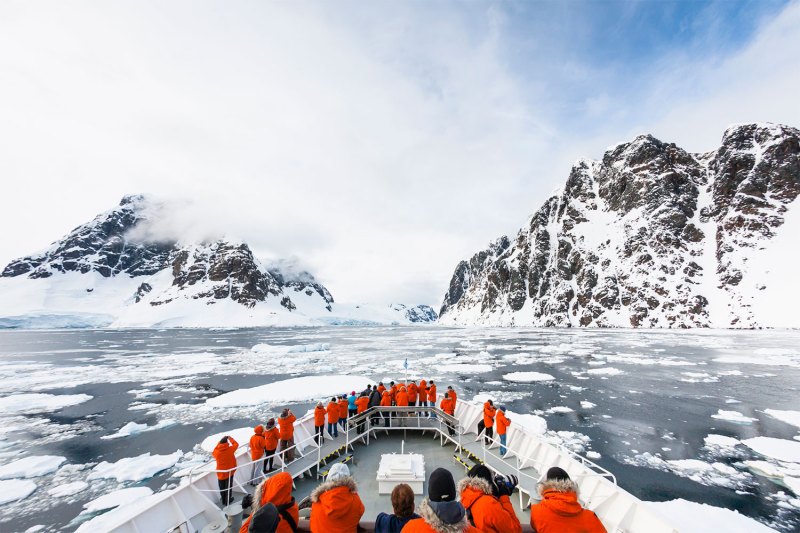
The White Continent. The South Pole. Terra Australis. The Bottom of the World. Call it what you will, the frozen continent of Antarctica has entranced mankind for centuries, sometimes with deadly results. Once solely the abode of hardy explorers and scientists, today, thanks to expedition cruises and other tour options, Antarctica is easier to access for the general public than ever (though it still carries a hefty price tag). Getting to see this legendary continent is a once-in-a-lifetime experience, so whether you’re daydreaming about making the trip someday, are in the planning stages, or have your bags packed and are looking for some relevant reading material for that Drake Passage crossing, these are the best books to read to learn about the history, ecology, wildlife, myths, and future of the rarefied place at the end of the world that we call Antarctica.
South: The Endurance Expedition by Ernest Shackleton

Irish explorer Ernest Shackleton is one of the most important figures in Antarctic exploration history, leading several expeditions to the continent during the Heroic Age of Antarctic Exploration (the late 1800s to the end of World War I) and also being one of the first to attempt to reach the South Pole (alongside Capt. Robert Falcon Scott and Roald Amundsen, the latter of which ultimately took the prize in 1911). But he’s best known for his 1914-1917 Endurance expedition. Known as the Imperial Trans-Antarctic Expedition, on this trip Shackleton and his crew were attempting to make the first land crossing of the continent when their ship, the Endurance, was first trapped and then crushed by pack ice. With his surviving men forced to camp on the disintegrating sea ice, Shackleton and the crew took the lifeboats and rowed 830 miles of stormy, dangerous seas to reach Elephant Island and then South Georgia Island looking for help. This daring exploit cemented Shackleton’s place in the history books for his heroism and bravery, and in South: The Endurance Expedition, he writes his own account of what happened. For lovers of historical autobiographies and explorer lore, this is a great read, told straight from the man who experienced it all.
Endurance: Shackleton’s Incredible Voyage by Alfred Lansing

While Shackleton’s personal telling of the Endurance expedition provides a visceral thrill, the personal log/diary-style writing style might not grab everyone’s attention, so for an alternative, there’s Endurance: Shackleton’s Incredible Voyage. Even with the personal autobiography as competition, this account of the ill-fated expedition is arguably the best out there. Arrestingly told with flair and a journalist’s eye for detail, Alfred Lansing’s retelling is an essential part of the Antarctic canon, making readers feel like they’re along for the ride. This is a great one to read while traversing the Drake Passage on your ship, as the passage’s notoriously stormy and deadly seas still produce sea sickness in travelers, and while you’d be experiencing a less-severe version, you can personally imagine what Shackleton and his men went through to reach civilization by rowing these treacherous waters for help.
Terra Incognita by Sara Wheeler

Apart from the Antarctic Peninsula and outlying islands, it’s much more difficult for civilians to spend time on the continent proper due to the cost and logistics. As such, the main continent of Antarctica is largely populated by scientists and researchers, living in research and field stations. But once a year, the U.S. National Science Foundation hosts a small number of writers, artists, photographers, painters, and other “scholars of the humanities” to spend time on the continent, with the goal of producing artistic work that furthers the public’s understanding and awareness of the continent. For seven months, Sara Wheeler was one of those lucky few artists-in-residence, and Terra Incognita was one of the resulting books. A travel writer by trade, Wheeler read through many of the great
The Worst Journey in the World by Apsley Cherry-Garrard

Back before getting to Antarctica became so accessible and easy, gliding over the choppy Drake Passage in your palatial suite with champagne and gourmet meals, getting to and then exploring Antarctica was a real ordeal; some would call it the worst journey in the world. British explorer Apsley Cherry-Garrard did and he made that the title of his account of Robert Falcon Scott’s Terra Nova expedition, a scientific and exploratory expedition that resulted in Scott’s death. As a zoological assistant on the expedition (for which he lacked the proper education and training), Cherry-Garrard was part of a small team that traversed the Ross Ice Shelf to fetch emperor penguin eggs at a rookery. It was this journey, through negative double-digit temperatures and brutal winter storms, that makes up the bulk of the narrative, and which Cherry-Garrard deemed “the worst journey in the world.” But he also talks about how he was part of the team that went in search of Scott and his team after they went missing returning from the South Pole, and how they found the bodies. Unlike many other accounts of Antarctic travel, this one is frank in its questioning of whether all the suffering and loss is worth it, and delves into difficult questions about human nature. Sobering and direct, this is a good one to read to remember the human sacrifice it took to open this continent to the world.
The Birthday Boys by Beryl Bainbridge

For a broader view of the Terra Nova expedition, this novel provides a captivating fictionalized version of the trip. The book is divided into five different first-person accounts from different members of the crew: Captain Robert Falcon Scott, Dr. Edward Wilson, who served as the ship’s medic and biologist, Lieutenant Henry Bowers, Petty Officer Taff Evans, and Captain Lawrence Oates. Each gives their own different version of events during the expedition, as well as their own thoughts about the successes, failures, and ultimate tragedy of Scott and his men’s passing while coming back from the South Pole having failed to beat Norwegian explorer Roald Amundsen to the Pole. Bainbridge also incorporates elements of postmodernism (a movement defined by attitudes of irony and skepticism), so in some ways, the reader is not sure what is entirely true or not. This is a great one to read if the wide-open seas and isolation are getting to your head.
Among Penguins: A Bird Man in Antarctica by Noah Stryker

One of the most popular reasons for visiting Antarctica is to see penguins; the continent is home to 18 different species of penguin, the most famous being the stately emperor penguin. So if your goal for an Antarctic adventure is to see and learn more about penguins, this book is a must-read. Shortly after graduating from college, the author went to Antarctica to work at a field camp with two bird scientists and to study the local penguins. Although the book is full of insightful and useful information and anecdotes about penguins, it’s Stryker’s wit and passion that really shines and drives the narrative as he talks about his various adventures and those of his colleagues. Educational and fun, it’s a quick and easy read. And with so many accounts out there about explorers, this is a fascinating look at the lives of scientists on the continent and the world of Antarctic science, which is too often ignored or overlooked.
The Last Place on Earth: Scott and Amundsen’s Race to the South Pole by Roland Huntford

The race between Robert Falcon Scott and Roald Amundsen during the early years of the twentieth century to see who could reach the South Pole first is one of the great stories of Antarctic discovery and adventure. In the dual biography of both men, Roland Huntford does a brilliant job of giving the cultural, social, and political background as to why the South Pole was such a coveted goal, and then taking readers through the pair’s race to the Pole, which Amundsen reached on December 14, 1911, five weeks before Scott. As one of the great rivalries and races of human exploration history, this is a true historical thriller that will have you on the edge of your seat. Great for reading during long travel days between islands or when crossing the Drake Passage to add a bit of spice and thrill to your day.



